
We
stayed for about a week at Kathleen's mother's house. We had a
nice time and were able to meet most of the folks that we wanted in
that period. But, after a week, we moved on. Our plan was
to continue east on Long Island to the eastern-most point of
Montauk. From there, we would backtrack a bit and then take
ferries over to the Connecticut mainland.
The photos below are what we saw.

We
stayed at Hither Hills state park right on the beach to the east of
"the Hamptons", almost to the eastern end of Long Island. It was
a pretty nice camp, but did not have any utilities. For us, that
is generally not a problem, but in this case, we discovered that our
on-board water tank was leaking water into the cabin of the
camper. We dried things as best we could and then broke camp and
went to the beach. Above is a shot of the very nice south-facing
beach. The beach was clean and had lifeguards.

A
view of the beach looking to the west of our position. Give the
(general) proximity to NYC, there really were not that many folk
there. We got one of the very few camp sites left when we arrived
and were happy to get it.

From
the camping area, we headed east to Montauk Point. Above is a
shot of the lighthouse at Montauk Point. We had information that
there was another unimogger in the area, but we were unable to
establish contact with him, so we moved on.

From
Montauk, we traveled west to Sag Harbor and then took the ferry to
Shelter Island.

At
Shelter Island, we had to take another small ferry to get off the
island to the REAL ferry that would take us across the Long Island
Sound to Connecticut.

Everywhere
we went along the water there were shacks and hovels. This hovel
looks like it has 3 fireplaces and about 20 rooms.

The
cross sound ferry was a full size ship. Because of the length of
the mog, they got their pound of flesh from us. The fare was
about $65 for a trip of about 80 minutes. But, it saved 4 hours
of road work that would have taken us through the thick of Brooklyn and
Bronx near rush hour. Truly a no-brainer.

As
the ferry pulled out of the dock, we got a view of the infectious
disease test site on Plum Island. Plum is a restricted area
reserved for dangerous pathogen research, but frankly I would have felt
better if it had been much farther from land.

As
we neared New London, CT we got a view of the New London Lighthouse
built in 1909.

The
path of the ferry gave us a clear view of the University of Connecticut
campus with its nice brick buildings.

More
shacks on the waterfront. But, much to the chagrin of the owners,
just to the left of the houses is a huge power plant.

The
power plant had its own mooring area for off-loading fuel for the plant.

The
ferry route took us past a submarine undergoing repairs on the river.

Upstream from the ferry landing was the awesome I-95 bridge over the river.

Next
to the ferry landing was the dock for the high-speed, passenger-only
ferry.

Mike
Hessling invited us to stay at his place and met us at the dock with
his 406. Like my rig, he has a bit of body rust, but the unit is
mechanically sound. He uses it frequently.
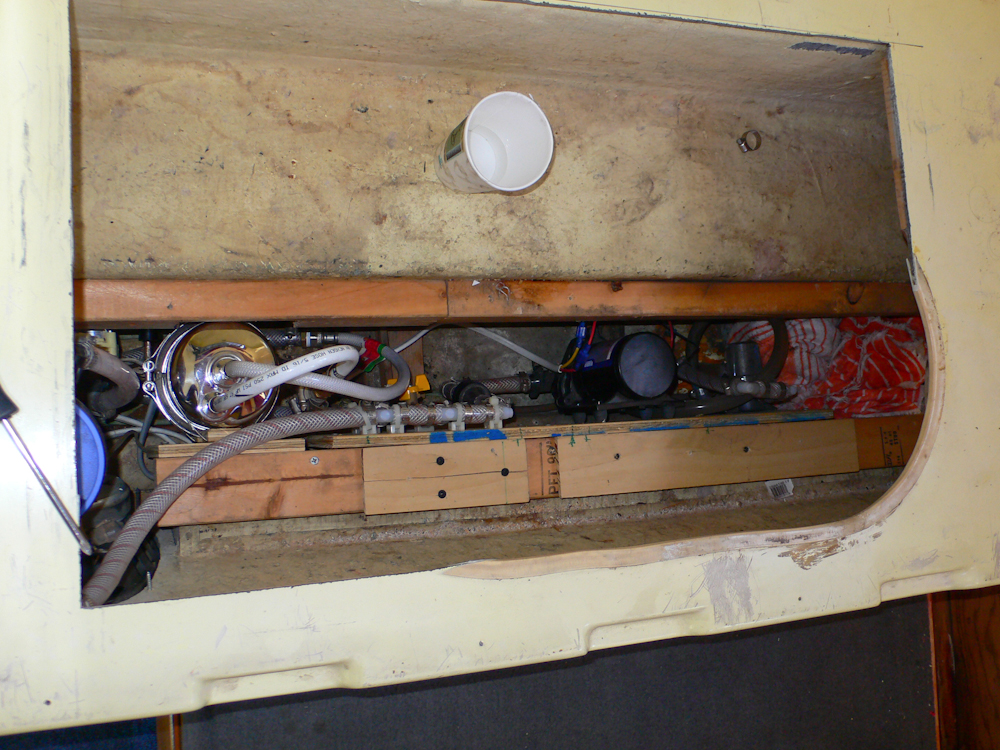
When
we were at our beach camp, we noticed some water on the floor of the
camper. Investigation revealed that we had a leak. Close
investigation revealed that the leak appeared to be coming from the
tank, not the hoses or fittings. Not good news. But, on the
other hand, when I redid the plumbing, I designed it so the camper
could run off "shore water" without the tank in the loop. So,
depending on what our deep inspection showed, the worse case is that we
would be inconvenienced by having to use bottled water when remote
camping. Camping in an RV park with water hookup would be "as
usual". Above, I pulled the flooring in the storage compartment
to gain access to the plumbing. Note the towel soaking up some
water in the bilge area.
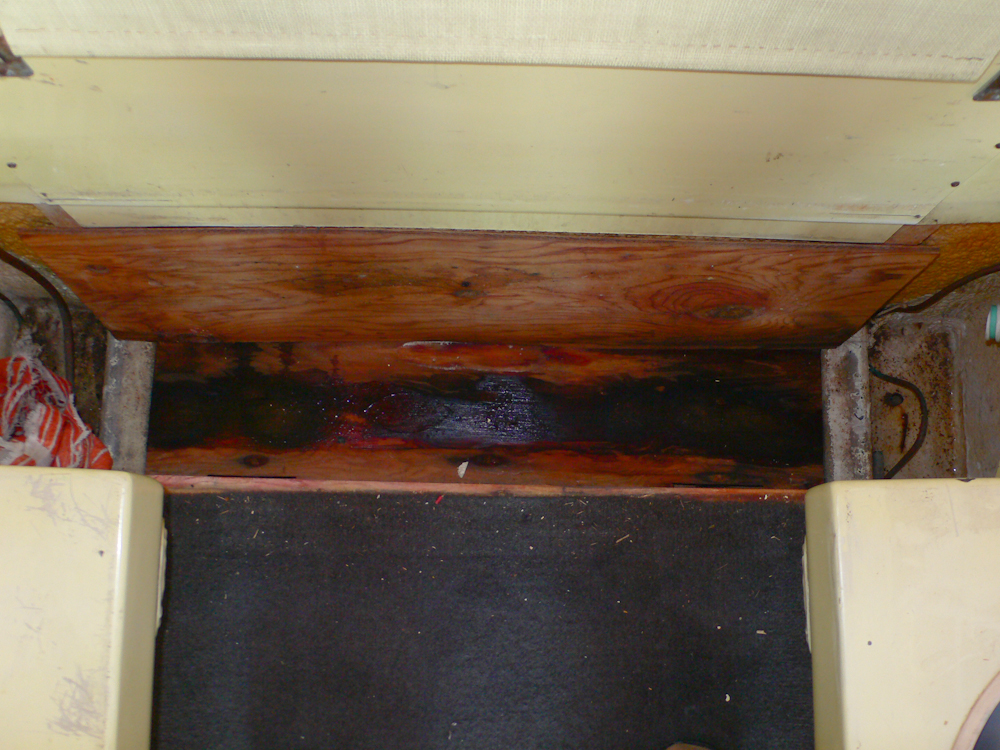
Mike and I pulled the tank and revealed that the wooden support underneath was soaked and had been that way for quite awhile.
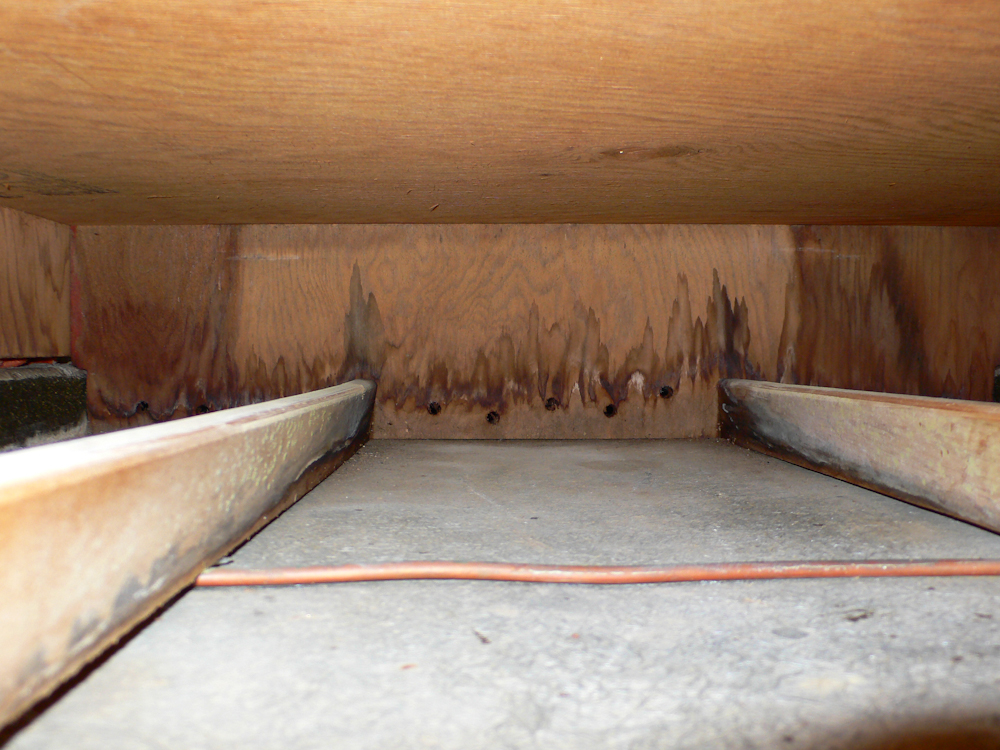
A view underneath the flooring of the dinette area revealed that the wood there was wet as well and showed mineralization stains suggesting that the problem had been going on for "awhile".
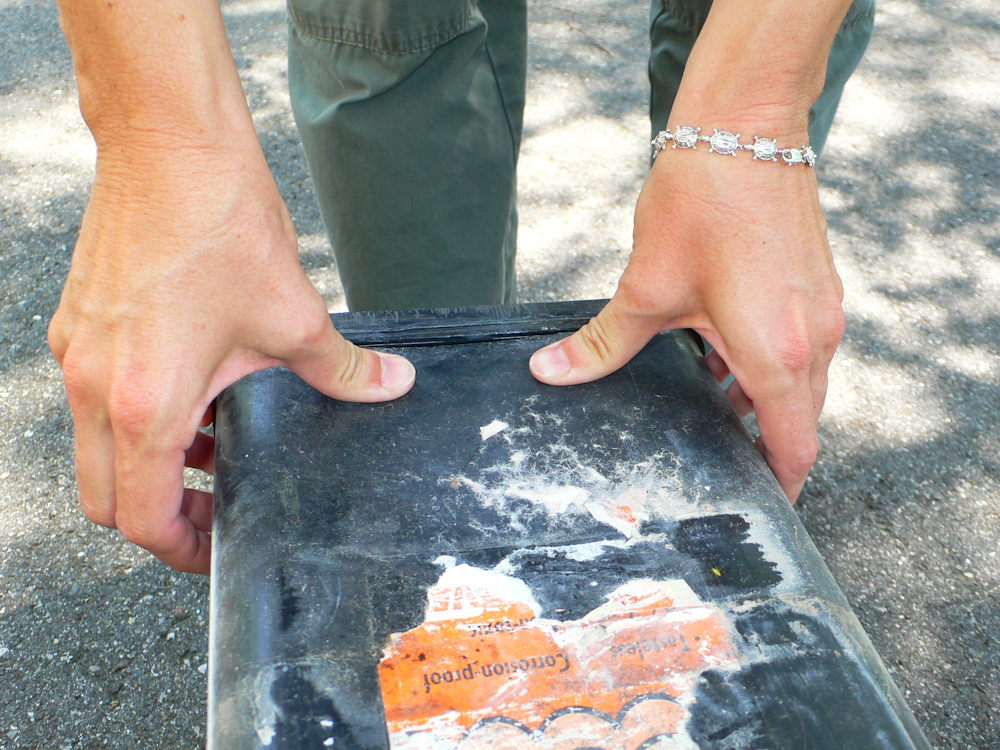
Mike
found one of the problems: the upper seam had separated allowing water
to slosh out. When I saw this, I ordered another tank
online. But, sadly, the tank would not arrive for at least a
week. So, we decided to attempt a repair. If the repair
failed, no big deal; we would be no worse off than if we did not
attempt the repair. I had the new tank shipped to Mike's place
and we will return to Waterford, CT in a few weeks to install it.
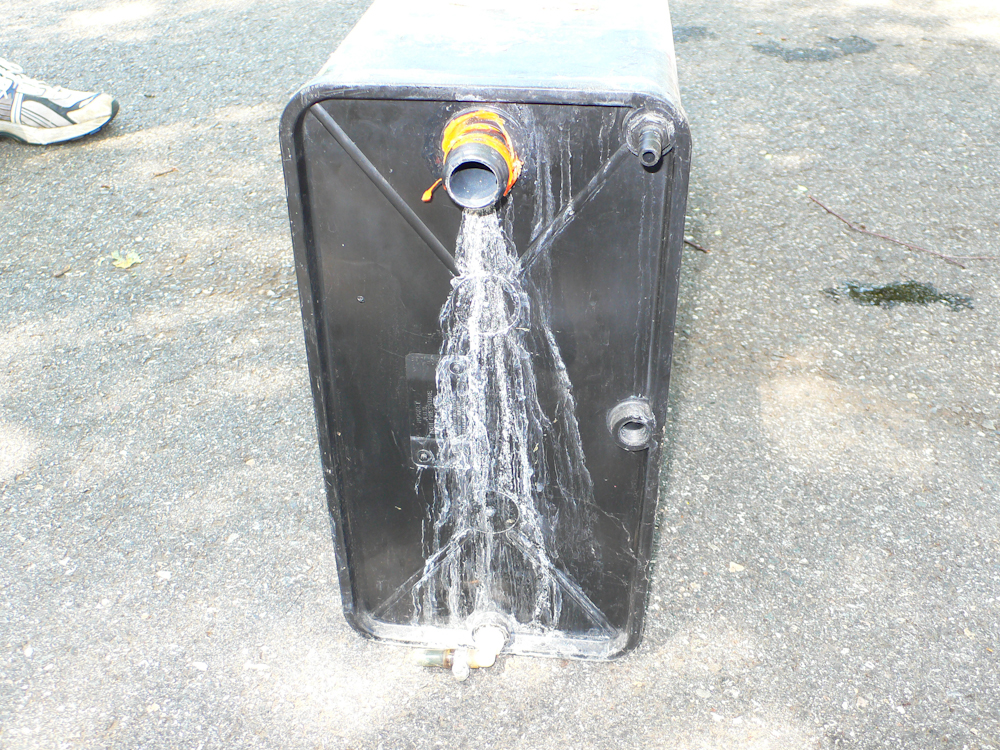
A
view of the side of the tank showed more mineralization stains, but
these may not be directly related to the current problem. In
addition to the calcium encrusted shut off valve, we discovered that
the internal slosh baffle had broken loose and was flopping around
inside the tank. This tank's days are numbered.
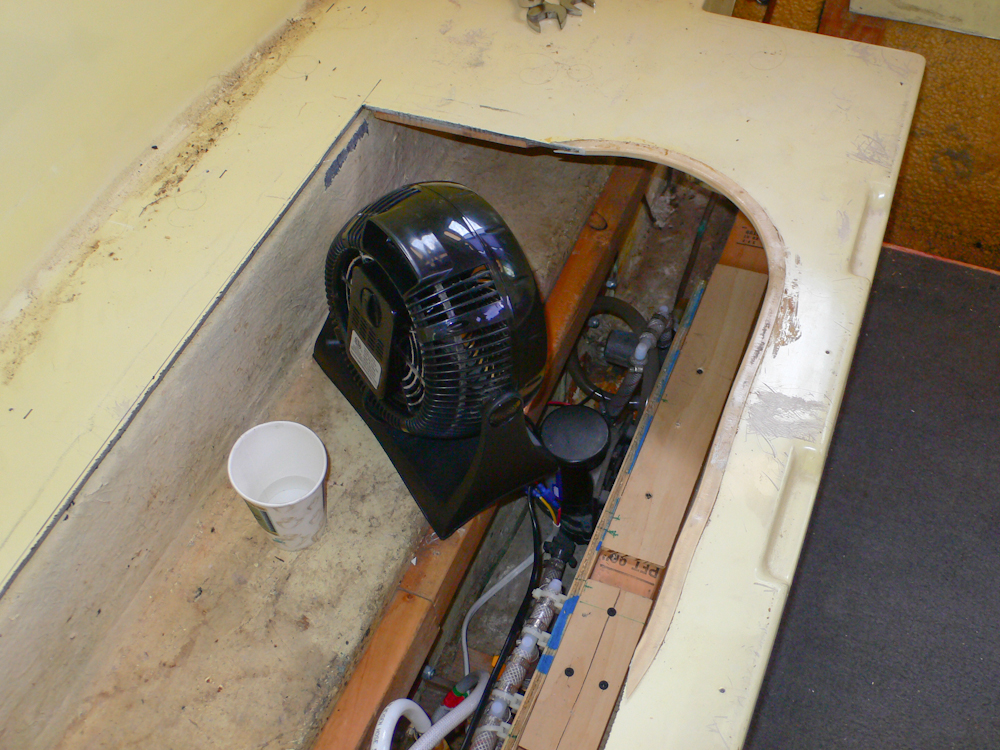
I had to use a fan to help dry out the area in the plumbing hold to prevent mildew and generally musty smells.
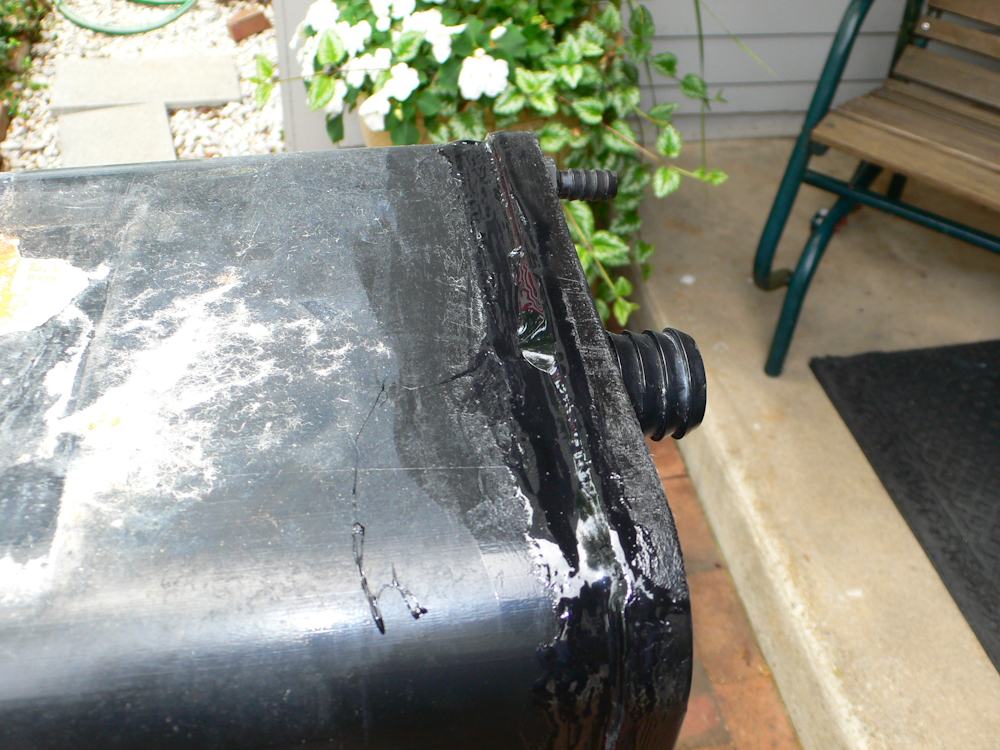
Mike attempted a repair of the existing tank with ABS glue. We coated all the seams and then did a fill test to try to identify any remaining leaks. The test showed no leaking, but as it turned out, it was not a sufficient test.
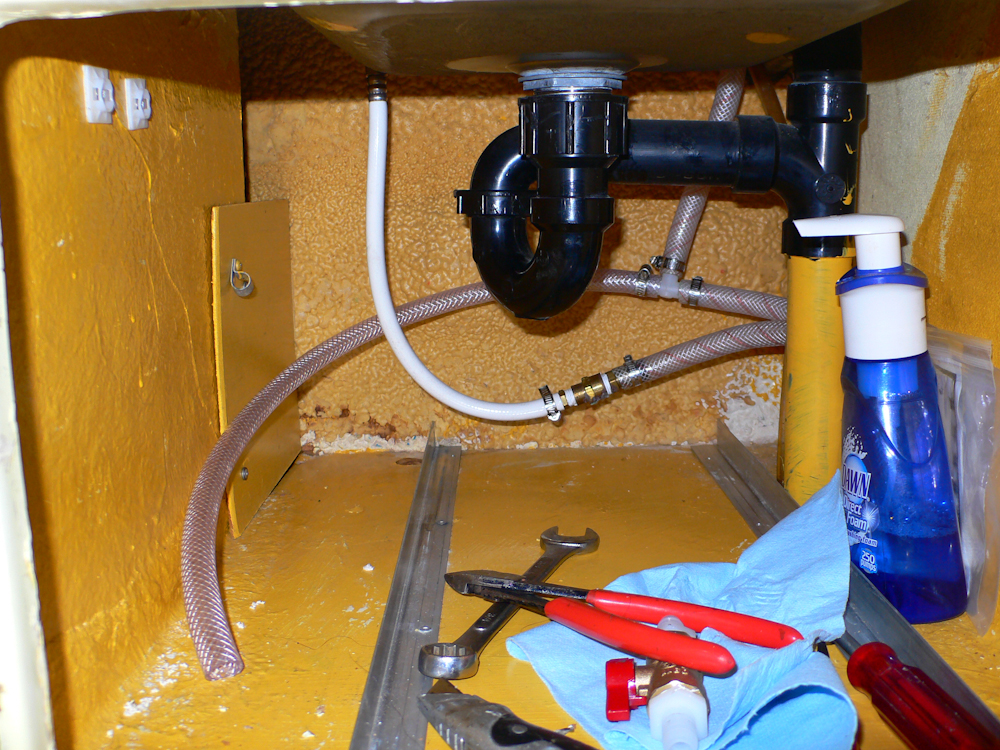
While I had everything torn apart, I decided to replace the fill lines to the tank. The valve that came off the tank was mostly occluded with calcium deposits, so that might explain the excessive fill times for the tank. 1/4" copper hard line was replaced with 1/2" braided plastic pressure line and a new valve.
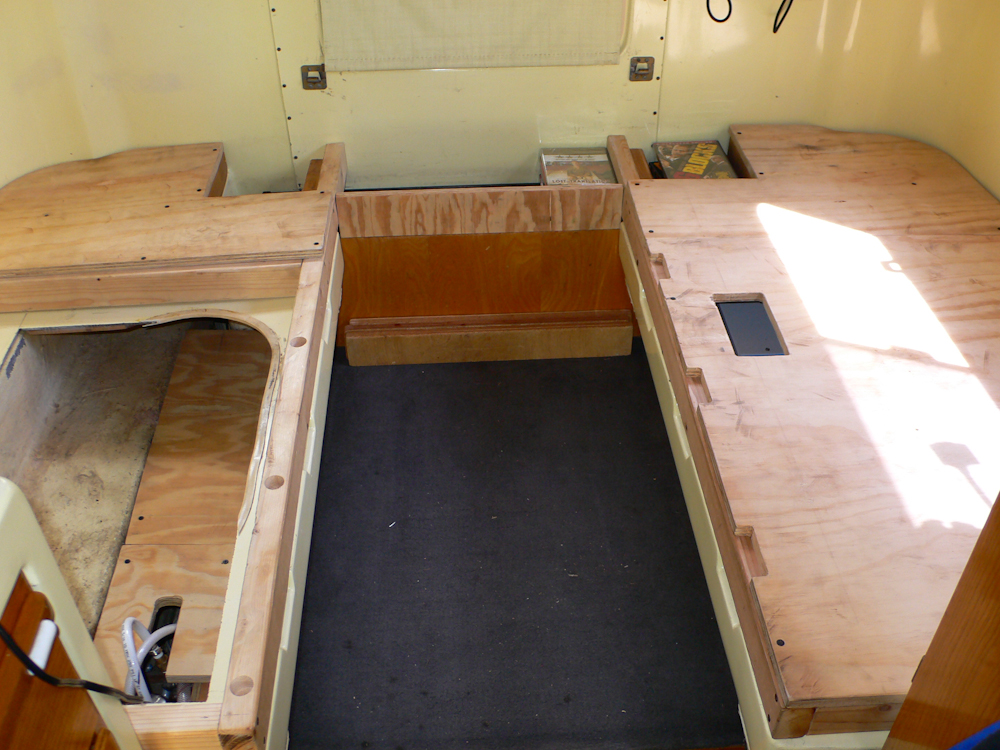
We
re-installed the supposedly repaired tank and filled it in situ.
The tank still leaked, so we drained it and put the whole assembly back
together. Above, the hold is put back together before we started
loading our equipment and personal gear. The wooden bolsters were
not part of the camper; I added them because the seats were too low and
were uncomfortable to sit on for any extended period of time.

Once
we had our rig put back together and all of our gear was loaded, we
headed east toward Rhode Island. On our way to Conanicut Island,
we had to pass over a pretty large bridge.

Next
to the bridge was a small lighthouse, one of many we saw that day.

We passed more shacks on the shore.

We
went south to Beavertail Point to check out the lighthouse there and
look for a camp site. Above is a view of the West Passage in
Narragansett Bay. The shores are rocky and many ships have
grounded in this area due to fog, bad weather, mechanical failures or
general incompetence on the part of the crew.

The
Beavertail Lighthouse is pretty wimpy compared to some of the other
lighthouses that we have visited. But, the museum was nice.
The lighthouse is constructed of large stone blocks so it is
mechanically robust. Beavertail is a RI state park, but there is
no camping allowed. The docent at the museum told us to go back
up the road a few miles and there was a camp area on the water.
So, we headed out.

On our way to the camp site at Fort Getty, we spotted these planes doing aerobatic maneuvers.
We greatly
appreciated the kindness of Mike and Barbara in letting us stay at
their place. And, I am especially thankful that Mike was able to
assist me in attacking the leaking tank issue. While our
attempted repair did not work, we did set the stage for an easy
replacement when the new tank arrives in a week or so. Thanks
Mike, we owe you.
The New
London/Groton area has many interesting things to see. We will
investigate it further upon our return in several weeks.
Meanwhile, we headed toward Cape Cod.
| Previous Adventure | ||
| Trip Home Page |
Photos and Text Copyright Bill Caid 2010, all rights
reserved.
For your enjoyment only, not for commercial use.